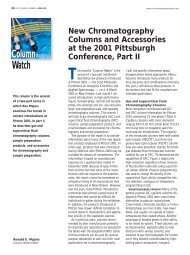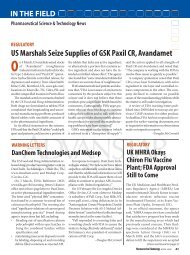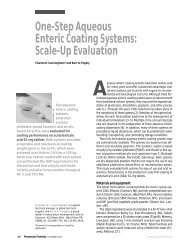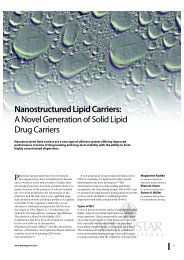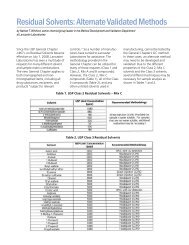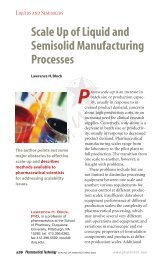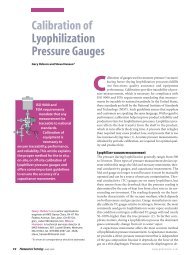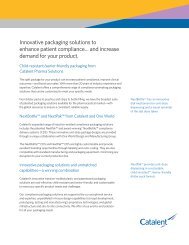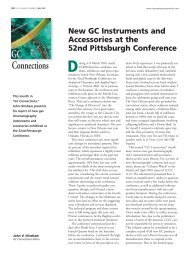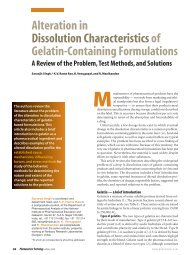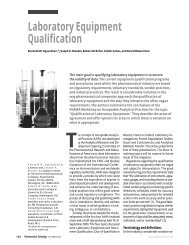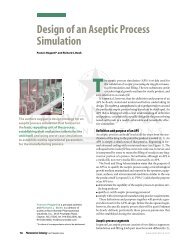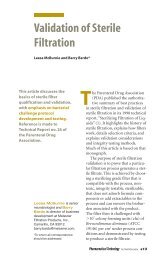The Role of the Column in Preparative HPLC - Chromatography ...
The Role of the Column in Preparative HPLC - Chromatography ...
The Role of the Column in Preparative HPLC - Chromatography ...
You also want an ePaper? Increase the reach of your titles
YUMPU automatically turns print PDFs into web optimized ePapers that Google loves.
428 LCGC NORTH AMERICA VOLUME 22 NUMBER 5 MAY 2004 www.chromatographyonl<strong>in</strong>e.com<br />
fected because <strong>the</strong>ir capacity factors are<br />
quite high <strong>in</strong> <strong>the</strong> <strong>in</strong>itial mobile-phase composition.<br />
Never<strong>the</strong>less, fractions <strong>of</strong> <strong>the</strong> first<br />
two eluted anthocyan<strong>in</strong>s (identified as<br />
peaks 1 and 2 <strong>in</strong> <strong>the</strong> chromatogram <strong>of</strong> Figure<br />
5) were collected automatically from<br />
<strong>the</strong> preparative column and identified by<br />
<strong>the</strong>ir UV and mass spectra (7) as delph<strong>in</strong><strong>in</strong>d<strong>in</strong>-3-galactoside<br />
and delph<strong>in</strong><strong>in</strong>d<strong>in</strong>-<br />
3-glucoside, respectively. By re<strong>in</strong>jection<br />
onto an analytical column, <strong>the</strong>ir purities<br />
were determ<strong>in</strong>ed to be greater than 99%<br />
and greater than 97%, respectively.<br />
Successful Use <strong>of</strong> <strong>Preparative</strong><br />
<strong>Chromatography</strong><br />
Many <strong>of</strong> <strong>the</strong> factors <strong>in</strong> successful analytical<br />
<strong>HPLC</strong> are prevalent <strong>in</strong> preparative <strong>HPLC</strong><br />
also, but some are even more <strong>of</strong> a factor.<br />
Because samples <strong>in</strong> preparative applications<br />
<strong>of</strong>ten are crude mixtures, impurities can<br />
accumulate at <strong>the</strong> head <strong>of</strong> <strong>the</strong> column and,<br />
if not removed, can cause peak shape and<br />
retention time change. Sometimes accumulated<br />
impurities do not affect retention but<br />
can change <strong>the</strong> column pressure, so one<br />
must watch for <strong>in</strong>creased column pressure.<br />
It is a good idea to flush <strong>the</strong> column occasionally<br />
with <strong>in</strong>creas<strong>in</strong>gly stronger solvents<br />
to remove bound impurities (8). Build-up<br />
<strong>of</strong> material <strong>in</strong> a packed column occurs<br />
most frequently when <strong>the</strong> <strong>in</strong>jection solvent<br />
is weaker than <strong>the</strong> mobile phase and is<br />
especially noticeable when isocratic elution<br />
is used. <strong>The</strong> stronger solvent strength used<br />
<strong>in</strong> gradient elution tends to help with<br />
removal <strong>of</strong> strongly held impurities. Silicagel<br />
adsorbent tends to hold onto more<br />
polar analytes, especially basic compounds,<br />
while reversed-phase pack<strong>in</strong>gs tend to favor<br />
more hydrophobic impurities.<br />
Know<strong>in</strong>g <strong>the</strong> history <strong>of</strong> <strong>the</strong> preparative<br />
column is <strong>of</strong> utmost importance. Because<br />
impurities from previous samples can show<br />
up unexpectedly when new preparative<br />
separation conditions are developed, it is<br />
advisable to start with a fresh column, or if<br />
this is not feasible, it is recommended to<br />
go through a solvent wash<strong>in</strong>g procedure at<br />
<strong>the</strong> very least. Of course, if <strong>the</strong> cost <strong>of</strong> <strong>the</strong><br />
solvents required to regenerate <strong>the</strong> column<br />
is more than that <strong>of</strong> pack<strong>in</strong>g or column<br />
replacement, <strong>the</strong>n it makes sense to replace<br />
<strong>the</strong> pack<strong>in</strong>g or replace <strong>the</strong> column. For<br />
self-packed columns, unpack<strong>in</strong>g <strong>the</strong> column<br />
and externally clean<strong>in</strong>g <strong>the</strong> loose<br />
pack<strong>in</strong>g material might be easier than<br />
attempt<strong>in</strong>g to clean it <strong>in</strong> <strong>the</strong> packed column.<br />
Often, <strong>the</strong> first few centimeters <strong>of</strong> a<br />
column suffer <strong>the</strong> most contam<strong>in</strong>ation,<br />
and remov<strong>in</strong>g this material and replac<strong>in</strong>g it<br />
with fresh pack<strong>in</strong>g can be performed<br />
relatively easily.<br />
S<strong>in</strong>ce both adsorption and reversedphase<br />
th<strong>in</strong>-layer chromatography (TLC)<br />
plates are now available, dur<strong>in</strong>g method<br />
development and transfer to <strong>the</strong> preparative<br />
adsorption column, <strong>the</strong> use <strong>of</strong> TLC<br />
can be helpful for quickly optimiz<strong>in</strong>g <strong>the</strong><br />
mobile-phase composition, for not<strong>in</strong>g <strong>the</strong><br />
presence <strong>of</strong> strongly reta<strong>in</strong>ed compounds<br />
at <strong>the</strong> po<strong>in</strong>t <strong>of</strong> spott<strong>in</strong>g (equivalent to <strong>the</strong><br />
head <strong>of</strong> <strong>the</strong> packed bed <strong>in</strong> <strong>the</strong> preparative<br />
column), and for qualitatively monitor<strong>in</strong>g<br />
<strong>the</strong> purity <strong>of</strong> collected fractions. With<br />
TLC, one can get an idea if <strong>the</strong> collected<br />
fraction is fairly pure or if additional<br />
method development is required. Of<br />
course, analytical <strong>HPLC</strong> can be used, but<br />
one is never certa<strong>in</strong> <strong>of</strong> <strong>the</strong> presence <strong>of</strong><br />
strongly reta<strong>in</strong>ed compounds that can be<br />
slowly eluted from <strong>the</strong> column to contam<strong>in</strong>ate<br />
subsequent isolated fractions.<br />
Some special techniques for ensur<strong>in</strong>g<br />
purity <strong>in</strong> preparative chromatography that<br />
are not used <strong>in</strong> analytical liquid chromatography<br />
are heartcutt<strong>in</strong>g and recycle.<br />
In heartcutt<strong>in</strong>g, just <strong>the</strong> middle portion <strong>of</strong><br />
a peak <strong>of</strong> <strong>in</strong>terest is collected and those<br />
portions <strong>of</strong> <strong>the</strong> peak <strong>in</strong> which <strong>the</strong>re is possible<br />
overlap with o<strong>the</strong>r sample components<br />
are discarded or sent to waste. Of<br />
course, <strong>in</strong> heartcutt<strong>in</strong>g, we sacrifice yield<br />
for purity. In recycle preparative chromatography,<br />
<strong>the</strong> effective length <strong>of</strong> a column<br />
is <strong>in</strong>creased by re<strong>in</strong>ject<strong>in</strong>g <strong>the</strong> column<br />
effluent that conta<strong>in</strong>s partially separated<br />
compounds <strong>of</strong> <strong>in</strong>terest back <strong>in</strong>to <strong>the</strong> head<br />
<strong>of</strong> <strong>the</strong> column, sometimes several times.<br />
Such a technique can be performed manually<br />
by collect<strong>in</strong>g <strong>the</strong> fraction <strong>of</strong> <strong>in</strong>terest<br />
and re<strong>in</strong>ject<strong>in</strong>g it <strong>in</strong>to <strong>the</strong> column. In<br />
modern <strong>HPLC</strong>-based systems, recycl<strong>in</strong>g<br />
can be done automatically us<strong>in</strong>g <strong>the</strong> alternate<br />
column-switch<strong>in</strong>g technique. In <strong>the</strong><br />
latter technique, two preparative columns<br />
connected by multiport valves are used<br />
alternatively to effectively leng<strong>the</strong>n <strong>the</strong><br />
time that a series <strong>of</strong> unresolved compounds<br />
spends on <strong>the</strong> column. Details <strong>of</strong> <strong>the</strong>se<br />
special techniques are beyond <strong>the</strong> scope <strong>of</strong><br />
this article.<br />
Conclusions<br />
Fur<strong>the</strong>r <strong>in</strong>formation about preparative<br />
chromatography columns and proper usage<br />
can be found <strong>in</strong> reference books and<br />
reviews devoted to <strong>the</strong> pr<strong>in</strong>ciples and<br />
applications (3,4,9–12). Modern preparative<br />
<strong>in</strong>struments coupled to high-efficiency<br />
and high-throughput columns have made<br />
<strong>the</strong> job <strong>of</strong> purify<strong>in</strong>g impure substances<br />
much easier. UV-based and mass-based<br />
fraction collectors can selectively cut eluted<br />
peaks to <strong>of</strong>fer additional fractionation<br />
capability. <strong>The</strong> outlook for preparative<br />
chromatography looks bright, with rugged<br />
preparative columns that can withstand<br />
many <strong>in</strong>jections now <strong>the</strong> norm, and fur<strong>the</strong>r<br />
work <strong>in</strong> special preparative phases<br />
such as monoliths and high-capacity sorbents<br />
will cont<strong>in</strong>ue.<br />
References<br />
(1) R.E. Majors, LCGC 22(3), 230–242 (2004).<br />
(2) R.E. Majors, LCGC 22(4), 322–337 (2004).<br />
(3) <strong>Preparative</strong> Liquid <strong>Chromatography</strong>, vol. 38,<br />
B.A. Bidl<strong>in</strong>gmeyer, Ed., (Elsevier Scientific,<br />
New York, 1987).<br />
(4) L.R. Snyder, J.J. Kirkland, and J.L. Glajch,<br />
Practical <strong>HPLC</strong> Method Development, 2nd ed.<br />
(Wiley & Sons, New York, 1997), pp. 50–56.<br />
(5) W. Long and R. Majors, “<strong>Preparative</strong> <strong>HPLC</strong><br />
Scale-Up <strong>of</strong> Antibiotics,” Application Note,<br />
Agilent Technologies, Inc., Wilm<strong>in</strong>gton,<br />
Delaware, February 2004.<br />
(6) W. Kalt, J.E. McDonald, R.D. Ricker, and<br />
X.Lu, Can. J. Plant Sci. 79, 617–623 (1999).<br />
(7) Clifford Woodward, “Scale-Up <strong>of</strong> Anthocyan<strong>in</strong><br />
Separations and Re-Analysis <strong>of</strong> Collected Fractions<br />
on an Agilent Prep-C18 <strong>Column</strong>” Application<br />
Note, Agilent Technologies, Inc., Wilm<strong>in</strong>gton,<br />
Delaware, February 2004.<br />
(8) R.E. Majors, LCGC 21(1), 19–26 (2003).<br />
(9) R.P.W. Scott, <strong>Preparative</strong> <strong>Chromatography</strong>,<br />
Chrom-Ed Book Series, [Onl<strong>in</strong>e] available:<br />
http://www.library4science.com/.<br />
(10) <strong>Preparative</strong>-Scale <strong>Chromatography</strong>, E. Grushka,<br />
Ed., (Marcel Dekker, New York, 1988).<br />
(11) “Scale-Up and Optimization <strong>in</strong> <strong>Preparative</strong><br />
<strong>Chromatography</strong>: Pr<strong>in</strong>ciples and Biopharmaceutical<br />
Applications,” Chromatographic Science,<br />
vol. 88, A.S. Rathore, Ed., (Marcel Dekker,<br />
New York, 2003).<br />
(12) <strong>Preparative</strong> and Production Scale <strong>Chromatography</strong>,<br />
G. Ganetsos and P.E. Barker, Eds., (Marcel<br />
Dekker, New York, 1992).<br />
Ronald E. Majors<br />
“<strong>Column</strong> Watch”<br />
Editor Ronald E.<br />
Majors is bus<strong>in</strong>ess<br />
development manager,<br />
Consumables<br />
and Accessories Bus<strong>in</strong>ess<br />
Unit, Agilent<br />
Technologies, Wilm<strong>in</strong>gton,<br />
Delaware,<br />
and is a member <strong>of</strong><br />
LCGC’s editorial advisory board. Direct correspondence<br />
about this column to “Sample Prep<br />
Perspectives,” LCGC, Woodbridge Corporate<br />
Plaza, 485 Route 1 South, Build<strong>in</strong>g F, First<br />
Floor, Isel<strong>in</strong>, NJ 08830, e-mail lcgcedit@lcgcmag.com.



